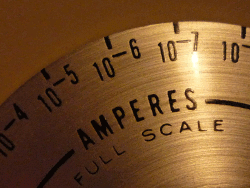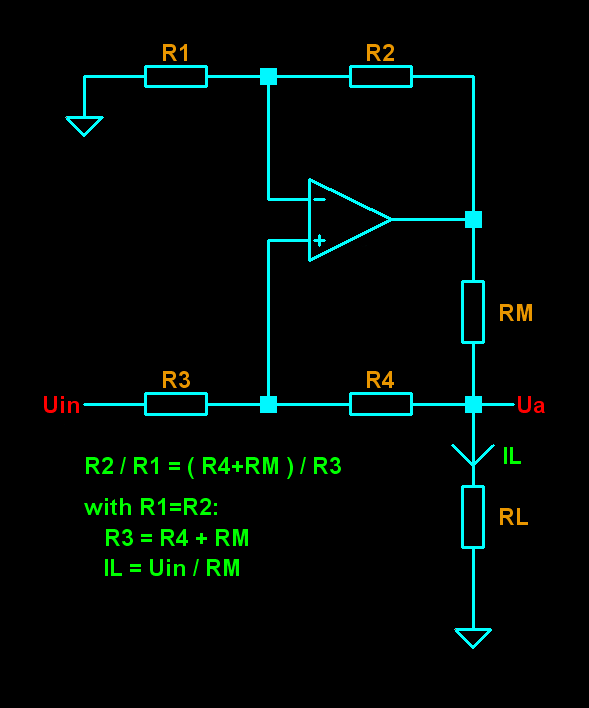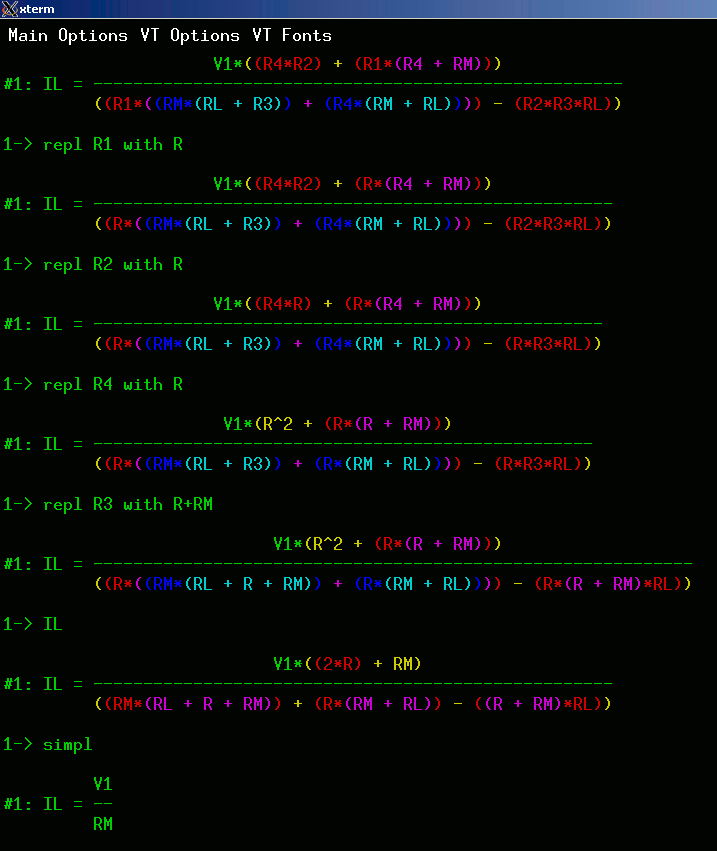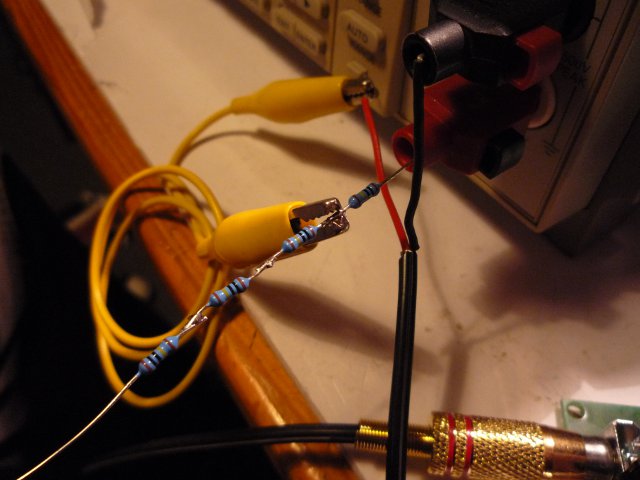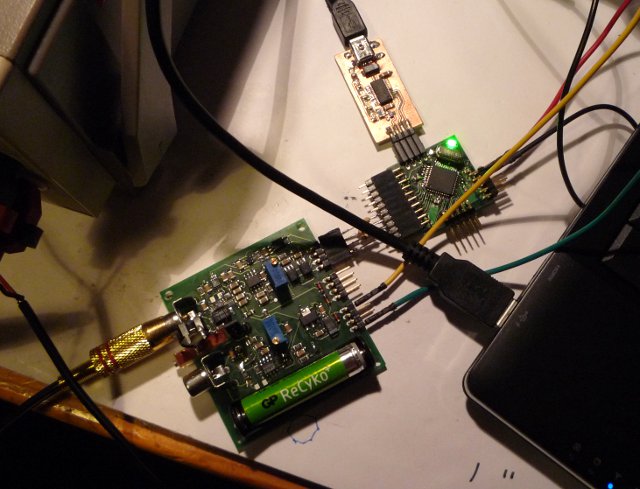LTCsourcerer, the Little Tiny Current source for automated uA measurements.
Features:
- 0..4095uA current source, 62.5nA resolution (16 bit)
- 0..~20mA current sink, ~310nA resolution (16 bit)
- digitally programmable
- galvanically isolated
- a lot of LT chips ;-)
- ...
Hardware
V2.0 schematic...
|
...and test layout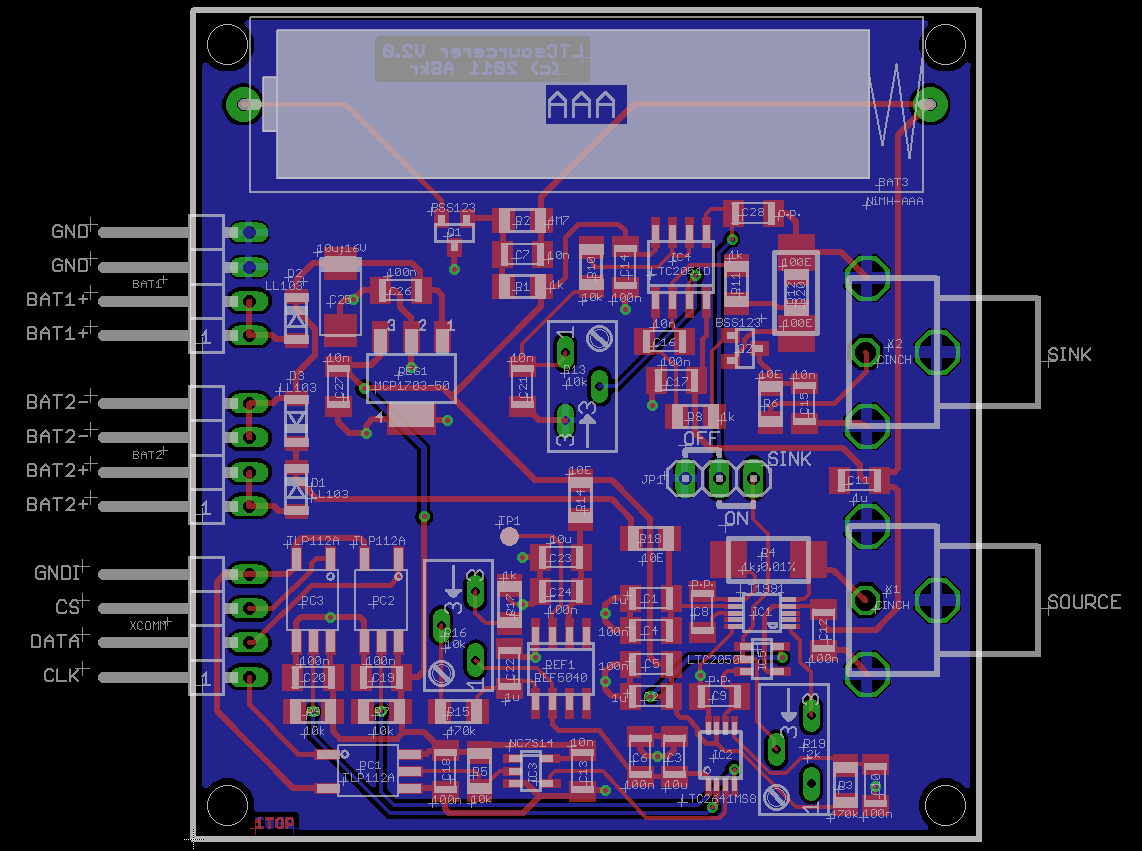
|
From time to time, the nice guys from Linear drop by in our R&D department, showing off their newest, best (and pricey ;-) chips. Although most of that stuff does not get built into our hardware, they always have a heart for private development... Now guess, where the name came from...
Just a handful of LT(C) chips, thrown onto a board, form this digitally controllable current source (and sink), suitable for automated measurements in the uA range.
Circuit Description
This little circuit offers- a precise current source, 0..4095uA with a resolution of 62.5nV (X1)
- and a "slightly less" precise current sink, 0..~20mA, with ~310nA resolution (X2)
Both units, source and sink, are operated by only one D/A converter (IC2, LTC2641), hence they can not be set individually (the sink is only a free bonus give-away ;-), except you disconnect JP1 and wire the input of IC4B to an external circuit.
|
Power SupplyFor proper operation, at least two batteries are required:
If power is turned off (BAT1, 2), Q1's gate is biased at -1.2V (R2) and the internal battery is "turned off" (read on) via Q1 too. But let us take a closer look at this:
At a glance, it might seem that this can not work properly. The current still can flow through
Q1's internal, parasitic substrate diode... Even if we assume Iq = 1uA, the lost charge Q within one year is
Q/a = 24h * 365 * 1uA = ~9mAh
A fraction (1%) of a modern NiMH cell's capacity...
Ua = BAT1 + BAT2 - 1V - ( Ia * 1k ) ; (*1*)
|
|
Reference, D/A and interfaceThe voltage reference, a REF5040 puts out 4.096V as a reference for the 16 bit D/A converter, a LTC2641-16.
If you don't like the default accuracy of the REF5040 (+-0.05% @ -40..125°C; usually better than 0.02% @ 25°C ;-)
you can tune it by adding circuit components R15-17 and C22. This allows an additional trim of ~+-20mV. The D/A converter is controlled by three inputs, CS, CLK and DATA. They are galvanically isolated via PC1-3 to eliminate ground loops and enable floating high-side applications. If you read the datasheet carefully, you'll notice the following:
Schmitt-Trigger Inputs for Direct Optocoupler Interface
Obviously, I overlooked this. Otherwise I would not have integrated IC3, a single-gate Schmitt trigger for a nice and steep edged clock signal... A discussion of the SPI protocol is beyond the scope of this tiny documentation. You may wish to scroll down to the download section. Maybe, there's some source code awaiting you... With a reference voltage of 4.096V, the 16 bit D/A converter ideally puts out:
Ua(n) = 4.096 / 65536 * n
Ua(1) = 4.096 / 65536 * 1 = 62.5uV Because of the high output impedance (~6k), a zero drift LTC2050 needed to be added. While the input offset of 3uV is quite impressive, the noise figure isn't. With 1.5uVpp (Rs=100E; DC..10Hz), these are about 2.5% of the smallest possible D/A step. The white noise and switching residuals (~7.5k chopper frequency) do not make things better. There might be better choices, but for now, I kept the focus on the input offset. C9 can be added to reduce noise (and slew rate). Same applies to C8. This will be discussed later on. |
|
Sinkto be continued... |
|
SourceThe source is configured as an improved Howland current source. This circuits acts as a voltage (Uin) to current (IL) converter.Often enough, you'll find web pages that tell you:
Uin |
IL = ------ |
RM | with R1 = R2 = R3 = R4; NOOOOO!
A quick, but observant look at the circuit proves this wrong...
Uin = 10mV
RM = 1k
RL = 1M
According to what these people try to tell you, the current through RL would be:
IL = 10mV / 1k = 10uA
With 10uA flowing through RM = 1MOhms, the voltage Ua across it would be:
Ua = 10uA * 1M = 10V
With, e.g. R1=R2=R3=R4=100k, we would expect Uop+ to be:
Ua - Uin
Uop+ = ----------- * R3 + Uin = 5.005V
R3 + R4
Exactly this voltage would be present at Uop- (Uop+ - Uop- = 0). With the same divider ratio
for R1 and R2, the OP's output voltage would be:
5.005V
Uop = -------- * ( R1 + R2 ) = 10.01V
R1
Ok. Now, according to what we calculated, the voltage drop across RM would be:
URM = 10.01V - 10V = 10mV
=> IRM = 10mV / 1k = 10uA
Now, if both the currents, IRM and IL are 10uA, the current through R3 and R4 would be 0.Obviously, this can not be true... If you take the time and work through the circuit by your own, you'll discover that:
(R4*R2) + (R1*(R4 + RM))
IL = Uin * ----------------------------------------------------- (*1*)
(R1*((RM*(RL + R3)) + (R4*(RM + RL)))) - (R2*R3*RL)
Even if this looks complicated (and I must admit, I did not reduce this to a nicer,
readable form), it should be obvious, that there's still a "RL" in the formula.It might become clearer if we set R=R1=R2=R3=R4:
Uin RM + (2*R)
IL = ----- * ------------
RM RL + (2*R)
Putting in the above values results in...
10mV 1k + 2*100k
IL = ------ * -------------- = 1.675uA
1k 1M + 2*100k
...which somehow differs from 10uA ;-)
No? Forget about all those Maximas, Mathematicas or Matlabs! Mathomatic is a must have and absolutely perfect for circuit calculations! END OF AD Right now, I decided that this is not an electronics course (And, didn't I already mention that my time is -somehow- limited? ;-). For an ideal OP, the resistance ratios should be:
R2 R4 + RM
---- = ---------
R1 R3
With R = R1 = R2, R3 solves to:
R3 = R4 + RM
If we take formula (*1*) and replace R = R1 = R2 = R4 and R3 = R + RM(see Mathomatic screenshot at right):
Uin
IL = -----
RM
That's how it is...
To reduce calibration orgies, the source uses two precision components: The LT1991 offers a 0.04% resistor matching (450k, over complete temperature range), 3ppm/K drift, 40mV rail to rail swing and more... The Vishay SMR1D resistor, the most expensive component in the circuit (~10EUR), has 0.01% tolerance and ~2ppm drift (25°C). These two parts really simplify the calibration process, we only have to worry about R19, the "Ua compensation resistor" and R16, which can compensate the reference voltage or offset problems (IC5, IC1). Unfortunately, there's no way of directly adding an additional slew-rate, bandwidth and noise limiting capacitor across IC1's output and negative or positive input. The only way attaching it is via pin 8 (M9) or pin3 (P9), which both have an internal 50k resistor.
Choosing C8 to 4.7nF reduces the bandwidth to ~12Hz (3dB) and attenuates ~20dB above 200Hz.
|
|
Calibration/Performance
|
Control Hard- and Firmware
|
Sharp PC-1403No, this is not a joke ;-) 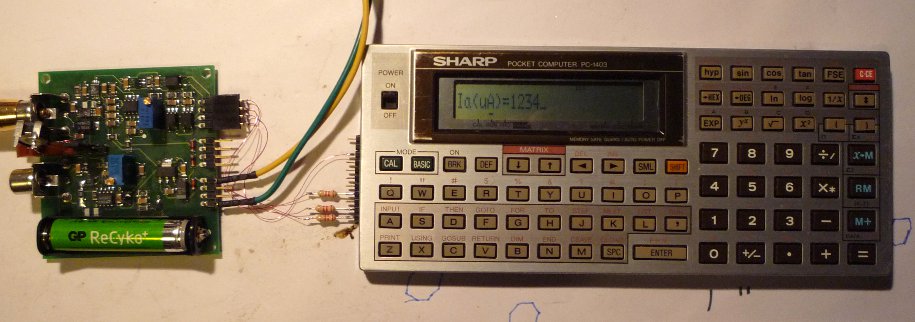
WARNING: Download in the download section (what a surprise...). |
|
PropellerThis is exactly what the Propeller can do best:Building a quick and dirty test setup...
|
Some Useless Pics
a simple weekend project...
|
...replaces most of this ;-)
|
LTCsourcerer:
DOWNLOAD: LTCsourcerer_hard_V20.zip Hardware, V2.0
Download
Includes:
- schematic (PDF)
- placement drawing (PDF)
- minimal BOM (TXT)
- layout, Eagle (BRD)
DOWNLOAD: LTCsourcerer_firm-prop_V01.zip Example Propeller firmware, V0.1
DOWNLOAD: LTCsourcerer_firm-pc1403_V01.zip Example Sharp PC-1403 software, V0.1
ASkr 10/2010: hand wired version
ASkr 02/2011: initial public release V1.0; fixed some typos (SCH) in V1.1
ASkr 03/2011: minor changes; HW-2.0; still no text ;-)
ASkr 03/2011: added some text, pictures and Sharp software

